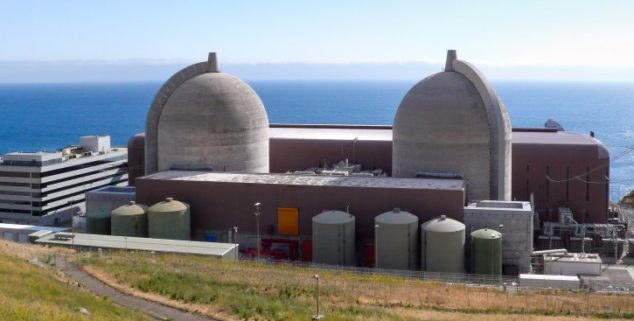Opinion
As climate change deepens, we need Diablo Canyon more than ever
 The Diablo Canyon nuclear power station in San Luis Obispo County near Avila Beach. (Photo: Wikipedia
The Diablo Canyon nuclear power station in San Luis Obispo County near Avila Beach. (Photo: WikipediaGov. Newsom’s announcement that his Administration would ask the California Legislature to authorize continued operation of the Diablo Canyon Nuclear Plant was welcomed by many energy experts. Keeping the plant open would improve the resilience of the state’s grid and decrease the likelihood of blackouts.
No governor, legislator or policymaker can responsibly ignore the multiple assessments showing that grid stability is at risk without Diablo Canyon.
The scheduled closure of the two Diablo generating units in the middle of this decade would create a very high risk of significant and numerous power outages, particularly given accelerating climate effects that have reduced hydroelectric resources and increased demand for electricity.
As the state struggles to build out new clean energy projects, closing one of its largest sources of carbon-free power would be a major mistake.
But decision-makers also can’t ignore California’s changing climate and its failure to keep on track to meet its climate goals. The state is at the front lines of climate impacts, suffering from wildfires, droughts, and heat waves. Despite California’s expansive efforts to address global warming by aggressively adding renewables, battery storage and energy efficiency, the necessary projects to meet the state’s climate goals — including transmission projects and other infrastructure — are simply not coming online fast enough.
As the state struggles to build out new clean energy projects, closing one of its largest sources of carbon-free power would be a major mistake.
Some oppose Gov. Newsom’s decision, advocating instead for simply “replacing” Diablo Canyon with renewable generation. But their framing of the issue is fundamentally flawed. We can’t pit one set of carbon-free resources against another, when what we need is to utilize all of them to protect the climate as fast as possible.
Retaining Diablo Canyon would displace gas generation and avoid 40 million metric tons of CO2 emissions over the next ten year
The issue is not Diablo Canyon versus renewables, which can and should be scaled up anyway. It’s Diablo Canyon versus the remaining polluting gas-fired power generation.
Almost every hour of every day, natural gas power plants are running to provide electricity in California and will run frequently well into the 2030s and probably longer. If Diablo Canyon shuts down, those gas plants will run even more often, many of them in communities already highly burdened with air pollution.
Even if we could replace Diablo’s generation with solar and wind, we’d still be running gas in its place until the entire grid is gas-free – and any serious advocate knows that won’t happen for a long time. Meanwhile, more carbon than necessary would accumulate in the atmosphere, creating irreversible warming and putting more and more Californians in harm’s way.
Retaining Diablo Canyon would displace gas generation and avoid 40 million metric tons of CO2 emissions over the next ten years, even if the state fulfills its ambitious doubling of annual renewable energy additions. In fact, Diablo Canyon would allow California to accelerate its 2045 zero-carbon grid goal by a decade.
Some also claim that the Diablo decision will distract the state from its clean energy path, but there is no evidence of that. On the contrary, in light of the climate crisis, demand growth and the need for higher reliability, the governor and legislators are proposing even more aggressive steps in favor of those resources, and the announced resource plans already assume we double to triple the rate of deployment of those technologies.
Electric costs would be $1.4 billion lower through 2035 with Diablo Canyon continuing to operate.
The real challenge for the state in meeting the mandated goal of a zero-carbon electric grid by 2045 lies in the difficulties of building adequate transmission to connect projects with load centers, in a byzantine permitting process, and in untangling supply chain issues rooted in geopolitical conflicts – not a lack of political will for clean power.
In case climate protection and grid resilience weren’t reasons enough, there is a clear economic case for keeping Diablo Canyon open as well. Relicensing the plant is not only economically viable, but will save ratepayers money.
A recent study conducted by the Brattle Group found that electric costs would be $1.4 billion lower through 2035 with Diablo Canyon continuing to operate, with savings even greater if the state is unable to rapidly achieve aggressive renewable energy and storage procurement goals or natural gas prices do not return to their pre-Ukraine levels, which are real risks. If the plant were kept online until 2045, Californians would save at least $4 billion in energy costs.
The planet is on fire, and California is squarely in its path. Turning the temperature down will require deploying every low carbon energy source we have. Diablo Canyon needs to stay in the mix.
—
Editor’s Note: Armond Cohen is President of the Clean Air Task Force, an environmental organization that advocates for a rapid transition to a zero-carbon energy system.
Want to see more stories like this? Sign up for The Roundup, the free daily newsletter about California politics from the editors of Capitol Weekly. Stay up to date on the news you need to know.
Sign up below, then look for a confirmation email in your inbox.

Leave a Reply